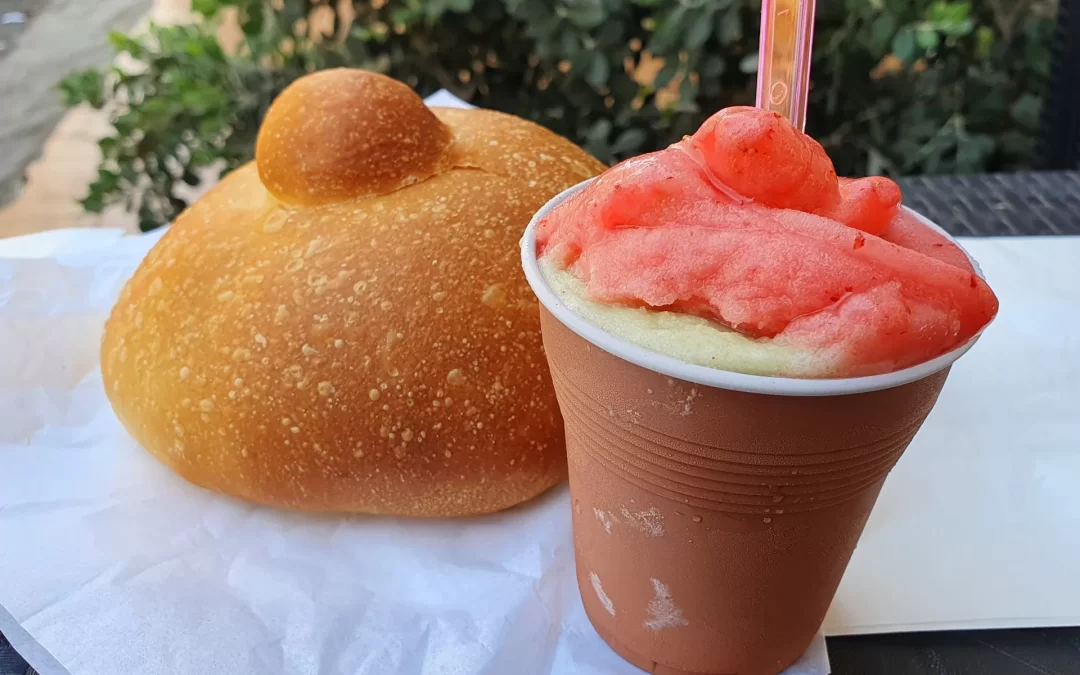Sicilian cuisine is the result of a mixture of different influences from the many cultures that inhabited the island over time.
It’s all in the mix
What still characterises our dishes today is a heritage of culinary traditions from very different civilisations that have contributed to the creation of an absolutely rich gastronomy, an explosion of flavours and colours. Greeks, Byzantines, Arabs, Normans, Swabians and many others have left profound traces of their way to Sicily, not only in architecture and culture, but also in the landscape, which has been changed by the various cultures that have been introduced, and of course in the art of cooking.
Sicilian cuisine’s soul has a double nature: can be rich, Baroque, very intensely tasting, full of sweets and elaborated dressing for fish and meat like the aristocratic meals used to be, or it can be very simple and poor, like the farmers, shepherds and fishermen meals used to be. For them a Salamarigghiu dressing (oil, lemon, oregano and salt) would be enough for a fresh fish, or even a bean soup with a bunch of wild fennel collected along a country road. Nowadays we still carry both way of cooking in our culture.
The particularly mild climate, along with the very fertile soil around Etna thanks to the volcanic activity, makes the eastern Sicilian coast extremely rich of fruits, vegetables and extraordinary vineyards.
To dine in a restaurant along Taormina bay or in one of its alleys, or enjoy the very fresh fish from Acireale coast, or have some lunch in a farm house se between Etna’s woods, is some experience you will never forget.
Whichever is your destination, wherever you are, exploring eastern Sicily you will be totally amazed by the local food.
Sicilian menu
Some of the best antipasti are without any doubts the Caponata, a mix of sweet and sour vegetables cooked with sugar and vinegar, and the Parmigiana made of fried aubergines baked with tomato sauce and cheese.
Some popular tradition main courses worth to mention are the Pasta con le sarde, cooked with fresh sardines and wild fennel, the Maccheroni alla norma, home made pasta in tomato sauce with fried aubergine and ricotta cheese, the Pasta al pesto di pistachio, which is a pesto made by pistachio nut, oil and salt using the best pistachio from Bronte, a town very famous all over the world for its production.
With regard to the main courses, it should be noted that the proximity to the sea makes its influence felt. Along the coast, the tables are set with courses of very fresh fish, while inland there are many more meat dishes.
Seafood goes from the very simple dishes such as Pesce alla griglia (grilled fish), Pesce marinato all’acqua pazza (marinated fish with tomatoes, onion and white wine), Involtini di spatola (fish rolls with breadcrumbs salt and parsley), to more elaborated dishes such as Pesce spada alla messinese (sword fish cooked with tomatoes, capers and olives), Calamari e totani ripieni (breadcrumbs and sun dried tomatoes stuffed squid), Tonno con cipolla (tuna steak with onions) and very fresh seafood salads such as Insalata di polipo (octopus salad with lemon and parsley).
Typical meat dishes are: Polpette in foglie di limone (meat balls cooked in lemon leaves), Salsiccia ai semi di finocchio (sausages with fennel seeds), Braciole di manzo (beef rolls in breadcrumbs), Scaloppine alla messinese (meat cooked in local wine).
You cannot miss the experience of the Granita con Brioche, the typical summery breakfast in eastern Sicily, which is a frozen fresh fruit smoothie served with cream and a homemade freshly baked brioche. And of course, the famous Cannolo alla ricotta, a crunchy biscuit filled with sweet ricotta cheese.
Street Food
The island’s street food also offers delicious temptations for the palate. Particularly typical of the eastern region are the crispy breaded rice arancino, stuffed with meat or pistachios or vegetables, the scacciata and the calzoni, softly baked or fried pasta stuffed with cheese, anchovies, ham.
Food culture around Sicily is so strong that it is almost impossible to walk around the towns at lunchtime, without sensing the smell of tomatoes sauce or fried food coming from the houses.
The kitchen becomes the beating heart of any home, where you can discover a mother or grandmother smelling of sugar and butter, busy practising the little big daily magic that gathers families around the table. Perhaps in a garden that smells of basil and lemons, facing the spectacle of Mount Etna rising from the sea.
